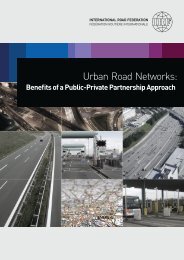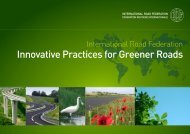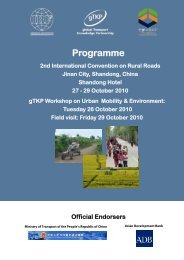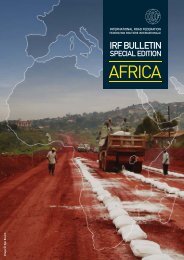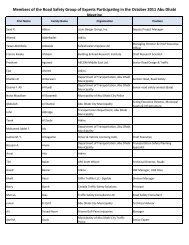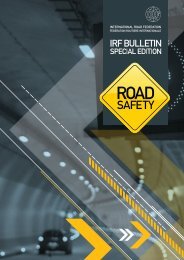TRANSPORT
TRANSPORT
TRANSPORT
- No tags were found...
Create successful ePaper yourself
Turn your PDF publications into a flip-book with our unique Google optimized e-Paper software.
SOCIO-ECONOMIC BENEFITS<br />
whole project cycle of planning, execution and routine<br />
maintenance. Project selection was based on a range of<br />
technical criteria, including feasibility of labour based<br />
methods, change in access, cost per capita and number of<br />
beneficiaries per kilometre. This latter was important for<br />
assessing whether the intervention would be maintainable<br />
by the local population.<br />
Quantitative double-difference analysis is demanding with<br />
regard to both quantity and quality of data. Thus, it was<br />
crucial to the success of the evaluation that sufficient<br />
information was available to draw up a ‘long list’ of<br />
communities sharing observable characteristics at the time<br />
of the interventions - to enable due comparison and analysis<br />
between communities that received support (treatment<br />
communities) and those (comparison communities) that<br />
did not.<br />
Importantly, the team benefitted from existing highquality<br />
data from the National Bureau of Statistics. The<br />
evaluation was, therefore, able authoritatively to measure<br />
a range of socio-economic indicators (before and after the<br />
interventions) as well as match household data among<br />
both treatment and comparison communities. Due to data<br />
constraints, the econometrical analysis was only possible<br />
in Las Segovias. The qualitative investigation similarly<br />
compared treatment and comparison communities. The<br />
comparison between quantitative and qualitative findings<br />
helped ensure the validity of the qualitative findings across<br />
the three regions.<br />
Whilst it is hardly surprising that construction of an allweather<br />
access road to a community should significantly<br />
reduce travel times, it remains, nevertheless, a key<br />
evaluation finding. It notably signifies that improved<br />
access has actually been established, opening the way for<br />
improved contacts with the outside world and changes in<br />
development processes. Supplementary data highlighted<br />
increased traffic levels and the establishment of scheduled<br />
transport services in PAST communities.<br />
PAST communities also showed a significant (17%) increase<br />
in the number of household heads in paid employment.<br />
New entrance to the labour market occurred mainly in<br />
agriculture, but employment gains were also observed in<br />
the construction sector. The qualitative analysis strongly<br />
supported these findings and confirmed that community<br />
members with experience in labour-based methods were<br />
finding employment in local municipal centres.<br />
The qualitative investigation also revealed other indicators<br />
of economic development following improved access.<br />
For example, land value and the amount of land used for<br />
agricultural activities increased in PAST communities, but<br />
remained unchanged in comparison communities. Other<br />
benefits included more frequent, timely and less expensive<br />
contacts with markets and buyers for agricultural products,<br />
resulting in improved prices and changes in production<br />
patterns. The degree to which such benefits materialised,<br />
however, varied according to types of productive activity<br />
and connections further into the transport network.<br />
Statistical analysis further confirmed that the average house<br />
size had increased significantly more in PAST communities<br />
than in the comparison communities. This is important<br />
since such investment can be seen as a proxy indicator for<br />
lower (transport) prices and/or improved resources. This<br />
was confirmed by the qualitative investigation.<br />
Social Impacts<br />
9,4 km road: Los Canales - La Manzanas<br />
Economic Impacts<br />
The analysis was able to demonstrate statistically significant<br />
impacts on important economic indicators – such as travel<br />
time, paid employment, connection to electricity grid<br />
and size of homes – as a proxy indicator for economic<br />
opportunities.<br />
The qualitative investigation highlighted that a key social<br />
impact for beneficiary communities was improved access<br />
to health services, especially for emergency cases. It also<br />
found that greater transport access made a positive impact<br />
on the frequency of care visits from health personnel,<br />
and on the quality of health posts. Parallel improvements<br />
were not reported in the comparison communities. Similar<br />
positive impacts were identified in the field of education,<br />
with improvements in teacher attendance, more materials,<br />
IRF BULLETIN SPECIAL EDITION: RURAL <strong>TRANSPORT</strong>, VOLUME-2 | 07






